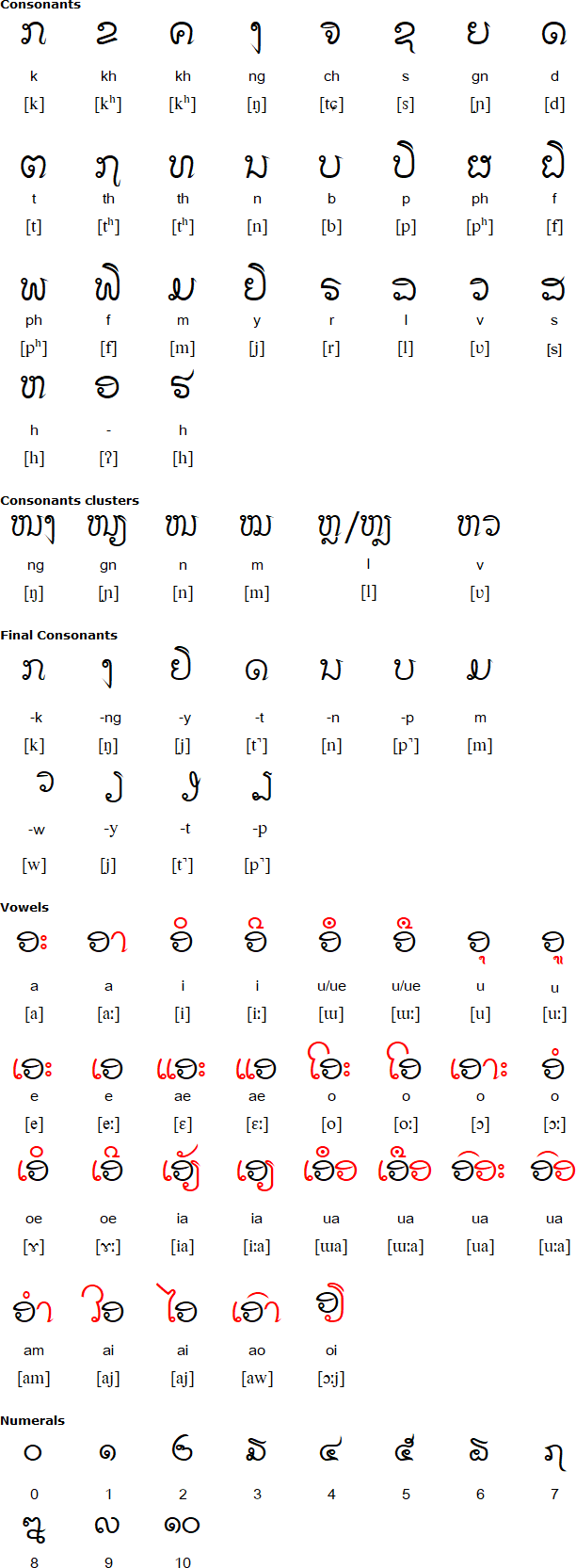
The Tai Noi script is a syllabic alphabet used to write Lao and Isan in Laos and northern Thailand from the 15th century until the 1930s. The earliest known inscription in the Tai Noi script dates from 1497 and was found in Thakhek, a town in Khammouane Province in central Laos. The most recent inscription in TaiNoi dates from 1840, although it continued to be used to some extent after that.
The roots of the Tai Noi script go back to the Pallava script of southern India, which was brought to southeast Asia and developed into the Khmer script. A version of the Khmer script was adapted to write Isan and Lao in the early 15th century. This became the Thai Lanna or FakKham script, which was used in northern Thailand from about 1400 to 1600. A simplified and more cursive version of this script emerged in the late 15th century to write Lao and Isan. Eventually, the Tai Noi script developed into the modern Lao script.
The spread of Theravada Buddism helped increase literacy and the use of the Tai Noi script as Buddisht monks taught boys to read and write so that they could read religious texts. The script was also used for record keeping, personal letters, signs, and for writing stories, poetry and songs.
Use of the Tai Noi script was banned in Isan in 1871 by royal decree, and it was replaced with the Thai script. However, the script continued to be used in informal education by monks until the 1930s, when Central Thai language and culture became the national standard, and other languages and cultures were suppressed. As a result, only a few elderly monks and academics are still able to write the script.
In the Isan region in the northeast of Thailand, the Tai Noi script is currently studied as part of courses in Isan language and literature at Khon Kaen University. These courses are part of efforts to revitalise the Isan language and the Tai Noi script. There is also a new version of the script, "New Thai Noi", which has been developed at Mahachulalongkorn University in Khon Kaen, and which include tone diacritics.
In Northeastern Thai, the Tai Noi script is known as อักษรไทน้อย (Akson Thai Noi) or “Little Tai Alphabet”, โตลาว (To Law) or “Lao letters”. In Lao, it is known as ລາວບູຮານ (Lao Buhan) or “Ancient Lao”, ອັກສອນລາວເດີມ (Akson Lao Doem) or “original Lao script”. It is also known as Tua Wiang (“Court Orthography”) or Thai Noi.

Download an alphabet chart for Tai Noi (Excel)

Information about the Tai Noi script
https://en.wikipedia.org/wiki/Tai_Noi_script
https://www.isangate.com/new/9-word/419-thainoi-alphabet.html
https://linux.thai.net/~thep/esaan-scripts/
https://theisaanrecord.co/2015/03/13/ancient-isaan-script-to-be-revitalized-in-new-public-effort/
Tai Noi fonts
https://www.f0nt.com/release/sov-tham/
https://www.isangate.com/new/images/fonts/fontthainoi.rar
Ahom, Aima, Arleng, Badagu, Badlit, Basahan, Balinese, Balti-A, Balti-B, Batak, Baybayin, Bengali, Bhaiksuki, Bhujimol, Bilang-bilang, Bima, Blackfoot, Brahmi, Buhid, Burmese, Carrier, Chakma, Cham, Cree, Dehong Dai, Devanagari, Dham Lipi, Dhankari / Sirmauri, Ditema, Dives Akuru, Dogra, Ethiopic, Evēla Akuru, Fox, Fraser, Gond, Goykanadi, Grantha, Gujarati, Gunjala Gondi, Gupta, Gurmukhi, Halbi Lipi, Hanifi, Hanuno'o, Hočąk, Ibalnan, Incung, Inuktitut, Jaunsari Takri, Javanese, Kaithi, Kadamba, Kamarupi, Kannada, Kawi, Kharosthi, Khema, Khe Prih, Khmer, Khojki, Khudabadi, Kirat Rai, Kōchi, Kodava Lipi, Komering, Kulitan, Kurukh Banna, Lampung, Lanna, Lao, Lepcha, Limbu, Lontara/Makasar, Lota Ende, Magar Akkha, Mahajani, Malayalam, Meitei (Modern), Manpuri (Old), Marchen, Meetei Yelhou Mayek, Meroïtic, Masarm Gondi, Modi, Mon, Mongolian Horizontal Square Script, Multani, Nandinagari, Newa, New Tai Lue, Ojibwe, Odia, Ogan, Pahawh Hmong, Pallava, Phags-pa, Purva Licchavi, Qiang / Rma, Ranjana, Rejang (Kaganga), Sasak, Savara, Satera Jontal, Shan, Sharda, Sheek Bakrii Saphaloo, Siddham, Sinhala, Sorang Sompeng, Sourashtra, Soyombo, Sukhothai, Sundanese, Syloti Nagri, Tagbanwa, Tai Noi, Takri, Tamil, Tanchangya (Ka-Pat), Tani, Thaana, Telugu, Thai, Tibetan, Tigalari, Tikamuli, Tocharian, Tolong Siki, Vatteluttu, Warang Citi
Page created: 17.03.25. Last modified: 19.03.25
[top]
You can support this site by Buying Me A Coffee, and if you like what you see on this page, you can use the buttons below to share it with people you know.

If you like this site and find it useful, you can support it by making a donation via PayPal or Patreon, or by contributing in other ways. Omniglot is how I make my living.
Note: all links on this site to Amazon.com, Amazon.co.uk
and Amazon.fr
are affiliate links. This means I earn a commission if you click on any of them and buy something. So by clicking on these links you can help to support this site.
[top]